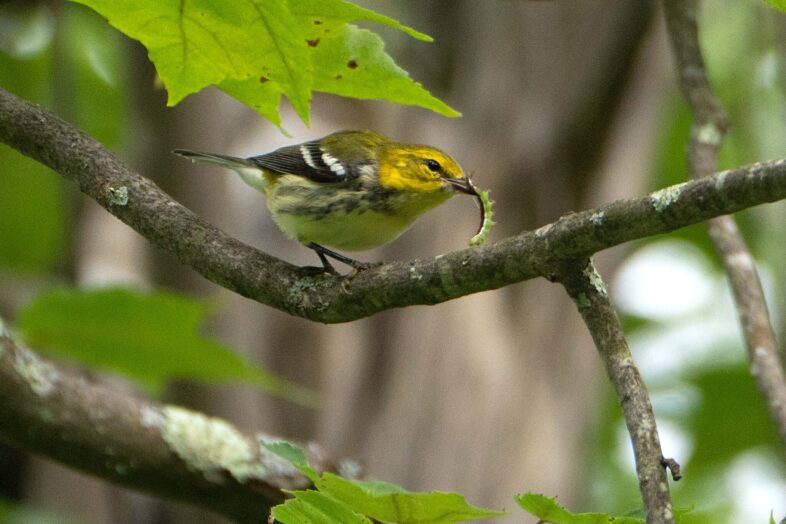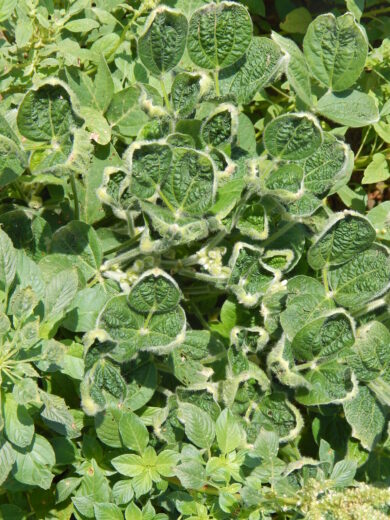
The damage from dicamba drift can potentially affect birds—like this Black-throated Green Warbler—by reducing their insect food sources. © Susan Elliott
If you’ve followed environmental or agricultural news over the past ten years, the name “dicamba” may ring a bell. It’s a controversial herbicide that has caused issues for both ecosystems and people. So problematic, in fact, that the use of its newest formulations was cancelled twice in five years due to lawsuits.
Despite the controversy surrounding dicamba, the Environmental Protection Agency announced in July its intention to authorize its sale to farmers—again.
Dicamba’s Origins
Dicamba first reached markets in the late 1960s and quickly gained popularity for helping everyone from farmers to homeowners snuff out stubborn weeds. It killed plants so effectively that farmers began applying it before the growing season to avoid damaging their crops.
Applying dicamba during the off-season months also helped farmers avoid its most notable issue. Dicamba is one of the most volatile herbicides, easily vaporizing both during and after application, and drifting beyond property lines where it can damage neighboring vegetation. Heat increases its evaporation, making cooler weather safer for application.
Despite this major drawback, dicamba has remained popular, with over 1,100 branded products containing it for sale today. When used with precautions, such as avoiding hot weather, dicamba poses little risk of drift affecting surrounding areas. In some cases, it has even helped ecological restoration projects manage invasive plant species.
The Controversy
But, if it’s relatively safe to use, why did dicamba make headlines in the 2010s?
By that point, farmers were battling weeds immune to glyphosate, the first herbicide intended for use on genetically engineered crops. Pesticide companies Monsanto and BASF saw an opportunity to offer something different and developed dicamba-tolerant genetically modified cotton and soy. With the risk of crops withering from direct exposure addressed, Bayer, BASF, and Syngenta launched new dicamba formulations designed to be sprayed directly on sprouted plants (referred to as “over-the-top” products).

Soybeans showing signs of herbicide damage © United Soybean Board
This expanded application of dicamba swiftly presented problems for both farming and ecological communities. With these new products greenlit for direct application, farmers began applying them during the growing season—the hottest months of the year—and people began to notice shriveled leaves and dying crops on the land near sprayed properties. In 2021 alone, the EPA received nearly 3,500 incident reports of drift-damaged vegetation from across the U.S.
When it comes to killing plants, dicamba rarely discriminates. Drift-related damage—curled leaves, fewer seeds, slower flowering—was documented in natural areas up to 25 miles away from the point of application, including in wildlife refuges that harbor vulnerable species. Die-offs of essential plant food sources can send a ripple through local ecosystems, impacting insect and bird species especially hard. One study published in early 2025 found a 70% reduction in insect pollinators within dicamba-exposed plots compared with untreated ones. Meanwhile, a report from the National Wildlife Federation pointed to a study showing how caterpillars feeding on plants treated with drift-level quantities of dicamba grew significantly less than those feeding on untreated plants.
Birds are vulnerable to these effects on insects. The same report noted that the young of over 90% of terrestrial bird species rely on insects for food. Many bird species also rely on seeds from the weeds that dicamba is designed to eradicate. Beyond food, birds (and other wildlife) rely on trees and woody vegetation for shelter and to raise their young. And birds cannot afford to lose more habitat. Bird populations have declined by 29% (almost 3 billion birds) since 1970, with habitat loss contributing significantly.
You can learn more about dicamba’s effects on wildlife and their habitats in this 2022 article from Audubon.
Legal Battles and Dicamba’s Next Chapter
The resulting damage from dicamba drift has triggered numerous lawsuits and led to two instances of the EPA being required to revoke its registration due to failure to follow proper public comment procedures. Today, these products are still banned, but that may soon change.
In July 2025, the EPA released a new set of documents outlining the details of re-registering the three over-the-top products, with sights set on restocking shelves in 2026.
In these documents, they outline measures to reduce drift, including prohibiting spraying when temperatures rise above 95 degrees. But without a clear plan for enforcement, advocates worry this won’t make a difference.
What This Means for Vermont
Agriculture is deeply rooted in Vermont’s economy and state identity. In the 2022 Census of Agriculture, Vermont harvested over 5,000 acres of soybeans, up 22% from the 2017 census. This makes the Green Mountain State by far the largest soy producer in New England (Maine is next highest at 970 acres in 2022).
While it’s unclear how much (or any) of this soy is dicamba-resistant, some farmers may be tempted to invest in a product that could increase their yields while decreasing costs. However, Vermont has already demonstrated a willingness to limit negative impacts of pesticides with the passage of Act 182, which restricts the sale of neonicotinoid-coated seeds.
As new threats emerge thanks to climate change and the influx of invasive species, officials can best support farmers and safeguard the wild species they steward with decisions based on evidence.

I am seeing it in Franklin County, the loss of herbivores, salamanders, frogs, good insects, birdlife, even the loss of coyotes which used to run at night. It is worse that Rachel Carson’s Silent S_ring, when she ex_osed DDT. THis is much, much bigger. How can I get involved? I have contacted Fish and WIldlife and the Ag De_t and have been ignored. Aso, we are seeing attacks of carnivorous insects on the local residents, as there are no bats. Checking out the trees; there is a severe loss of seeds, ie acorns and Acer whirligigs. none, how can we get involved? Others are seeing it, but it is very frightening. A true Silent S_ring, worse than DDT. (my keyboard is broken, but I had to contact you when I found this siste) thank you
There is a lot we can do!
1.Make your voice heard!! Write or call your state and federal legislators and the EPA, telling them you oppose the EPA’s effort to authorize the sale of dicamba again to farmers.
The herbicide dicamba drifts and can kill native plants, even a significant distance away and reduce native insects and birds that depend on these plants. Herbicides can also be toxic to amphibians and fish.
2. Buy organic and avoid GMO corn and soy!
Support your local farmers…and ask them to avoid using pesticides and herbicides if possible.
3. Support environmental organizations that fight against the use of pesticides and herbicides.
4. Plant native trees, shrubs and flowers that support native insects, especially our pollinators! Doug Tallamy has several great books on this.
5. Use iNaturalist to post photos and information about plants, animals, insects that you observe in nature….this citizen science project collects and provides important scientific data that can be used to help make good decisions about caring for our planet.
6. Share this VT Center for Ecostudies article about the risks of dicamba with friends and family and urge them to contact their legislators to oppose allowing its sale to farmers.